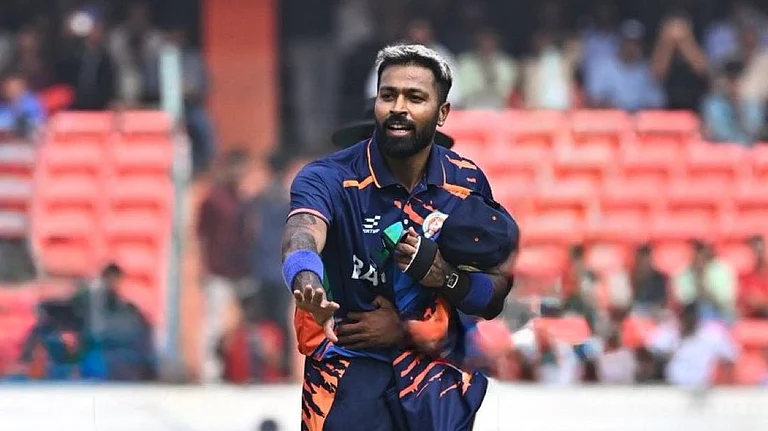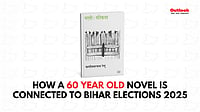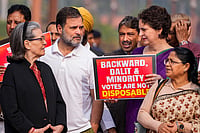Scattered debris from the construction sites painted with the tools that labourers use to build mansions welcome you to the world of Amebedkarite aesthetics. Beyond the speculative grandeur of abstract artworks, it talks to and of the people—the marginalised whose voices are rarely heard. Curated by Professor Y.S. Alone, the exhibition on the Art of Difference, titled ‘Interrogations and Ideologies: A Quest for Equality’ at the American Center, New Delhi, is representative of what the curator calls ‘anti-metaphysical aesthetic practice’, an effort to go against the grain.
As 16 artists from marginalised communities come together to reflect on the alternative visual culture, it becomes a space that represents the everyday lives of Dalits, women and the oppressed classes. The exhibition also portrays the lives of Dr Ambedkar and Jyotiba Phule whose contribution to the anti-caste movement dismantled the prevalent notions of caste hierarchy.
Professor Alone says, “Mahatma Phule and Dr Ambedkar are the prominent figures who raised their voices against caste, gender, labour and all kinds of exploitation. This is an integral part of the Ambedkarite thinking process and hence, their ideas become a critique of Brahminical hegemony, inequality and Brahminical modernity.”
In Knowledge We Trust
Education and knowledge have always been the focal points of the anti-caste discourse. This is manifested in the artworks and installations. Most of them have a blue backdrop—a colour strongly associated with Dalit movements. While artist Siddhesh Gautam’s paintings uphold the untiring struggles of Jyotiba Phule and Savitribai Phule to educate children, Ramabali Prajapati’s installation titled ‘Stairs of Success’, depicting a staircase made of cement, shows books as its foundational pillar.
The message ‘In God We Trust’ embossed on the iconic American bald eagle gets a new meaning in Darshan’s painting as he places it against a blue background and replaces the words with ‘In Knowledge We Trust’. Darshan says, “What I wanted to show with this satiric intervention is the significance of knowledge and education in the lives of the people, mostly the marginalised. So, I tweaked the message in an exhibition that is held at the American Center itself!”

Caste As Embodiment
But does education mitigate the impacts of caste hierarchy? Artist Ishita Abha who belongs to the Regar community—known for their leatherworks—talks about the embodiment of caste. Using transfer printing on leather, she shows how human existence is connected to the caste certificate. “Women’s bodies have always been used as caste fields. Whatever you do, the caste identity cannot leave you,” says Abha.
While pointing out that the very existence of people itself has become performance, she adds, “You think you are talking about reparation but this is not happening. The way I talk, dress and present myself is nothing but performance to not get caught when I am among the elite social circles. This is the way you gain respect and dignity.”
The exhibition provides a rare space for marginalised voices to reflect on their lived experiences. “The participating artists who belong to marginalised communities use their artworks to challenge the meta-narrative of the modernist, contemporary art practices of speculative and claimed hegemonic narratives,” says Professor Alone. Overcoming the ‘‘non-representation of the real issues of caste and gender,’’ these artworks engage in dismantling the aesthetics of inhibitions, he adds.
Depiction Of The Realities Of Life
Sometimes, direct representations become more powerful than abstract metaphysical ones. Poonam Grover’s Cycle Rickshaw series is a fine example. Observing the daily lives of the rickshaw pullers in the small town of Panipat in Haryana, Grover portrays the precarity of hand-pulling in the age of mechanically driven vehicles. The acrylic painting of a rickshaw puller on a large canvas looks viewers in the eye without using any visual metaphor or metonymy. Professor Alone says, “All the artworks here depict the realities of life rather than abstract ideas of par-Brahma. That’s a self-defeating attitude adopted by many practising artists who do not like to address issues of caste, gender and labour, which are an integral part of our society.”
The precarious lives of Dalits are captured in the artworks of Samyak Prajapati who uses graphic print on canvas to show the miserable conditions of child rag pickers in big cities. These artworks destroy the lens of exoticism and make viewers, mostly belonging to Savarna communities, uncomfortable. Sudharak Olwe’s photography series on the redlight area of Kamathipura in Mumbai invites viewers to shatter the dominant male gaze and to see ‘‘the abject conditionality and the hard reality of their lives.’’
Ambedkar As A Central Figure
Ambebdkar’s life is a constant in the exhibition. Malavika Raj’s work titled ‘Waiting for Visa’, named after Babasaheb’s short autobiography, portrays his experiences of untouchability in different stages of his life. Naresh Suna’s ‘Ineradicable’ is a large portrait of Ambedkar who is shown sounding his famous clarion call—Educate, Agitate, Organise.
Should such exhibitions be held in more accessible spaces than the American Center?
Professor Alone says, “In principle, yes, but how many places or galleries would like to host such exhibitions? I can curate bigger shows with many artists from all over India but I need a suitable space and a support system to do that.”
The impact of such exhibitions, nonetheless, is wide. It serves to make more people aware of alternative realms of art. Darryl K. Woolfolk, Public Diplomacy Officer, Public Engagement, US Embassy, says, “I really didn’t know much about Dr Ambedkar and his role in creating the Indian State. I found out that he was from the Dalit community. So, an exhibition like this that showcases his role in India’s evolution as a modern country is really significant.”
An art scholar who chooses to remain anonymous sums it up eloquently, “When the great artists of our time are busy portraying the prime minister’s ‘Mann ki Baat’, these works are a necessary breather that help to keep our faith in art intact.”
(This appeared in the print as 'Art from the Margins')



























